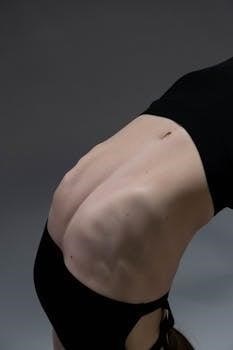The piriformis muscle, located in the buttock, can become tight and cause pain, known as piriformis syndrome. Stretching this muscle is crucial for relief. These stretches help alleviate pressure on the sciatic nerve, reducing discomfort and improving mobility.
Understanding Piriformis Syndrome
Piriformis syndrome is a condition where the piriformis muscle, a small muscle located deep in the buttock, irritates the sciatic nerve. This irritation can lead to pain in the lower back, buttocks, and legs, often mimicking sciatica. The piriformis muscle runs from the spine to the thigh bone, and when it becomes tight or inflamed, it can compress the sciatic nerve, causing discomfort and pain. Several factors can contribute to piriformis syndrome, including prolonged sitting, overuse, or injury. Understanding the cause of the discomfort is essential to implement the appropriate stretches and exercises for relief. It’s important to differentiate this condition from other causes of sciatica to ensure proper treatment.

Common Piriformis Stretches
Several basic stretches can effectively target the piriformis muscle. These include supine, seated, and standing variations, each designed to gently release tension and improve flexibility. These are the foundation for relief.
Supine Piriformis Stretch
To perform the supine piriformis stretch, begin by lying flat on your back with both knees bent and your feet resting on the floor. Gently lift the leg you wish to stretch and bring your knee towards your chest. Then, use the hand on the opposite side to grasp your ankle and pull it across your body toward your opposite shoulder. You should feel a gentle stretch in the buttock and hip area. Ensure to maintain a relaxed posture throughout the stretch. Hold this position for about 20-30 seconds, breathing deeply, and repeat on the other side. This stretch is a great way to start relieving tension in the piriformis muscle and is gentle enough to perform daily. Remember not to force any stretch and stop if you feel pain.
Seated Piriformis Stretch
To perform the seated piriformis stretch, sit upright on a chair with your feet flat on the floor. Cross the ankle of the leg you want to stretch over the opposite knee. Gently lean forward, maintaining a straight back, until you feel a stretch in your buttock. You can deepen the stretch by applying gentle pressure on the thigh of the crossed leg. Hold the stretch for about 20-30 seconds, breathing deeply and ensuring your muscles are relaxed. This seated version is an excellent alternative to the supine stretch and is easy to perform at a desk or during a break. Remember to repeat on the other side to achieve balanced relief. Avoid any sudden movements and listen to your body.
Standing Piriformis Stretch
The standing piriformis stretch is a simple yet effective way to target the muscle while on your feet. To begin, stand upright and place the leg you want to stretch slightly behind the other. Bend your front knee, allowing your hips to naturally shift. Now, gently lean forward, maintaining a straight back, until you feel the stretch in the buttock of the back leg. You may need to adjust the distance of your back foot to find the optimal position. Be sure to maintain a stable stance and focus on the stretch. Hold for 20-30 seconds and repeat on the opposite side. This stretch is particularly useful if you don’t have a chair or floor space available.

Advanced Piriformis Stretches
For those needing deeper relief, advanced stretches can target the piriformis more intensely. These variations involve increased range of motion and leverage, requiring more care and attention to form.
Piriformis Stretch with Ankle on Opposite Knee
This stretch is effective in targeting the piriformis muscle using a specific leg position. Begin by lying on your back with both knees bent and feet flat on the floor; Lift one leg and place your ankle on the opposite knee. This creates a “figure four” shape with your legs. Gently grasp under the thigh of the leg with your ankle on the knee, and pull both legs towards your chest. You should feel a stretch in the buttock and hip of the leg with the ankle on the knee. Maintain a gentle stretch, avoiding any sharp or intense pain. Hold the stretch for 20-30 seconds and repeat several times, alternating legs as needed. Remember to breathe deeply throughout the stretch to help relax the muscles.
Piriformis Stretch Pulling Knee to Opposite Shoulder
This variation of the piriformis stretch involves a more dynamic movement to target the muscle. Start by lying flat on your back, extending both legs. Then, bend one knee and lift that leg towards your chest. Using the hand opposite to the bent knee, gently pull the knee across your body towards your opposite shoulder. You should feel a stretch deep in the buttock and hip region of the bent leg. Avoid forcing the stretch and stop if you feel any sharp pain. Hold this position for about 20-30 seconds. Remember to keep your shoulders flat on the ground and breathe deeply throughout the exercise. Repeat the stretch several times on both legs to ensure a balanced stretch. This stretch helps to increase flexibility and relieve tension in the piriformis muscle.

Additional Techniques for Piriformis Relief
Besides stretching, foam rolling and self-massage can help release tension in the piriformis muscle. These techniques target trigger points, reducing pressure on the sciatic nerve and easing pain.
Foam Rolling for Piriformis Release
Foam rolling is a highly effective method for releasing tension in the piriformis muscle. By applying pressure to the muscle with a foam roller, you can target trigger points and knots that contribute to pain and discomfort. Begin by sitting on the floor with the foam roller positioned under your affected buttock. Gently roll back and forth, applying pressure as needed. If you encounter a particularly tender spot, hold the pressure for a few seconds before continuing. This technique helps to increase blood flow to the area, promoting relaxation and reducing muscle tightness. Remember to consult with a healthcare professional if you are unsure how to proceed with this technique or if you experience any pain.
Self-Massage Techniques for Piriformis
Self-massage is another valuable technique for relieving piriformis muscle tension. Using your fingers or a massage ball, apply gentle pressure to the area of your buttock where the piriformis muscle is located. Start with light pressure and gradually increase it as needed, focusing on any tender areas. You can use circular motions or back-and-forth strokes to massage the muscle. Pay attention to your body and avoid causing any sharp or intense pain. This technique aims to loosen the muscle and reduce pressure on the sciatic nerve. Consistent self-massage can contribute to improved flexibility and reduced discomfort. Remember to consult a healthcare professional if you have any concerns or experience persistent pain.

Piriformis Stretches in Different Environments
Water-based exercises provide buoyancy, reducing the effect of gravity. This allows for easier hip flexor and abductor stretches. The water supports the body, making movements more comfortable for those with pain or limited mobility.
Water-Based Piriformis Stretches
Performing piriformis stretches in water offers unique advantages due to the buoyancy and reduced impact. Water counteracts gravity, supporting the body’s weight, making stretches gentler and more accessible, especially for individuals with limited mobility or pain. The buoyancy aids in exercises that target the hip flexors and abductors, as they become easier to perform. In a pool setting, you can try a modified supine stretch by floating on your back and bringing one knee toward your opposite shoulder. The water’s resistance also adds a light strengthening element to these stretches. Another variation could involve gently rotating your hip while supported by the water. Always ensure the water is at a comfortable temperature and that you have a stable base. Remember to move slowly and avoid any movements that cause pain or discomfort. The water’s supportive nature helps in easing tension and enhancing the effectiveness of piriformis stretches.
Importance of Consistency and Other Exercises
Regular piriformis stretching is key to managing pain and improving mobility. Combining these stretches with strengthening exercises will provide better results, promoting long-term relief and overall hip health. Consistency is essential.
Integrating Piriformis Stretches into a Routine
To effectively manage piriformis syndrome, it’s essential to incorporate stretches into your daily or weekly routine. Consistency is key; aim to perform these stretches multiple times a day, especially if you experience frequent discomfort. Begin by warming up your muscles with light activity, such as a brief walk. Then, perform each stretch slowly and deliberately, holding for 20-30 seconds, and repeat each stretch a few times. Listen to your body and stop if you feel any sharp pain. Gradually increase the duration or repetitions as your flexibility improves. A routine can be as simple as stretching in the morning, after work, or before bed. Combining these stretches with other exercises, like strengthening routines, will provide optimal results, leading to enhanced mobility, reduced pain, and an improved overall quality of life.
Strengthening Exercises for Piriformis Syndrome
While stretching is crucial for relieving piriformis tightness, strengthening the surrounding muscles is equally important for long-term relief and stability. Exercises like glute bridges help engage the gluteal muscles, which support the piriformis. Seated leg raises and side-lying leg raises can also strengthen hip abductors and rotators. Walking sideways with a resistance band and performing front and side planks improve core and hip stability. The bird-dog exercise also enhances core strength and spinal stability. These exercises should be performed with proper form to avoid injury, starting with a lower number of repetitions and gradually increasing the intensity as your strength improves. Combining strengthening exercises with piriformis stretches can effectively reduce pain, improve muscle balance, and prevent future episodes of piriformis syndrome.
When to Seek Professional Help
If pain persists despite consistent stretching and exercises, it’s important to consult a healthcare provider or physical therapist. They can provide a proper diagnosis and personalized treatment plan.
Consulting a Healthcare Provider or Physical Therapist
If you experience persistent pain or discomfort related to your piriformis muscle, seeking guidance from a healthcare provider or physical therapist is a crucial step. They can accurately diagnose the root cause of your symptoms, ruling out any other potential issues that may be contributing to your pain. A physical therapist can provide personalized exercises and stretches tailored to your specific needs and limitations. They can also offer hands-on techniques, such as massage or trigger point therapy, to alleviate muscle tension. Furthermore, a professional can guide you on proper form and technique during exercises, ensuring you are performing them safely and effectively, while also providing advice on how to integrate these stretches into your daily routine. Consulting an expert can help you avoid any further injury, and help accelerate the healing process for long-term relief.
